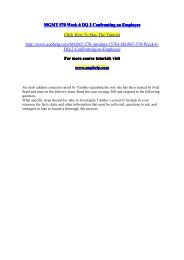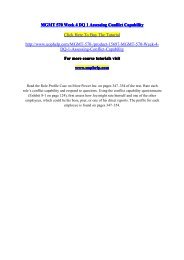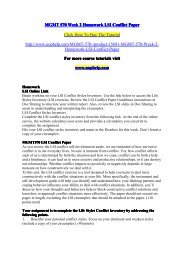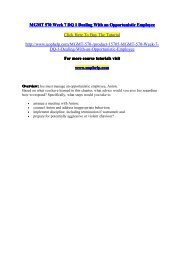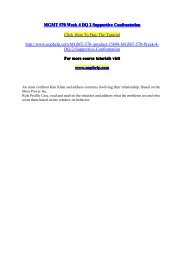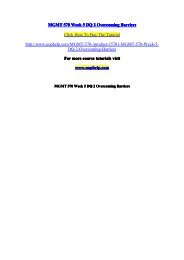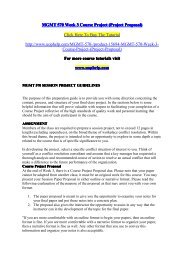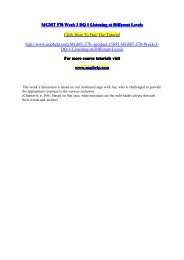MGMT 570 Week 5 Homework Collabarative case analysis
For more course tutorials visit www.uophelp.com Collaborative Case Analysis Students will work in teams to prepare a collaborative case analysis on the Negotiations for Life case (text page 202). Each team will be assigned either Scenario 1 or Scenario 2 by the professor. Teams will discuss their assessments in their team Discussion areas and prepare an analysis and recommendation in a collaborative report in the form of a paper. See MGMT570: Guidelines for Case Analysis located in Doc Sharing. The length of paper should be three to four pages, not including the cover page and references. APA style is required for in-text citation and references.
For more course tutorials visit
www.uophelp.com
Collaborative Case Analysis
Students will work in teams to prepare a collaborative case analysis on the Negotiations for Life case (text page 202). Each team will be assigned either Scenario 1 or Scenario 2 by the professor. Teams will discuss their assessments in their team Discussion areas and prepare an analysis and recommendation in a collaborative report in the form of a paper. See MGMT570: Guidelines for Case Analysis located in Doc Sharing.
The length of paper should be three to four pages, not including the cover page and references. APA style is required for in-text citation and references.
- No tags were found...
Create successful ePaper yourself
Turn your PDF publications into a flip-book with our unique Google optimized e-Paper software.
Situation Analysis: Another part of the <strong>analysis</strong> is to explain the mechanisms that are<br />
causing the conflict. (35 points)<br />
Ø Incorporate specific and relevant conflict resolution concepts.<br />
Avoid providing general or commonsensical responses that do not incorporate<br />
course concepts, as well as just simply summarizing <strong>case</strong> facts or examples.<br />
Ø Don’t make assumptions that cannot be supported by the facts in the <strong>case</strong>.<br />
Ø Be wary of imposing personal opinions on the <strong>case</strong> that cannot be supported by<br />
<strong>case</strong> facts or relevant conflict resolution concepts; try not to place blame.<br />
Ø Avoid providing viewpoints that are sketchy or overlook important course<br />
concepts, <strong>case</strong> facts, and events.<br />
Recommendation: All recommendations must be developed that are appropriate measures<br />
that will ensure that the conflict is resolved in order to develop a structured plan of action.<br />
Who is to do what and when? (35 points)<br />
¨ Your solutions should follow logically from your <strong>analysis</strong>.<br />
¨ Focus on the problems not the parties.<br />
¨ What are the expected outcomes (both positive and negative) of the solution?<br />
¨ What aspects of the conflict remain unresolved by your solutions?<br />
¨ Make sure recommended actions incorporate conflict resolution concepts and<br />
theories. Although these recommendations are speculative, you still need to be sure to<br />
incorporate relevant conflict resolution concepts and provide specific, concrete<br />
examples to help demonstrate or support your points.<br />
Evidence of Data Usage: Finally, there must be evidence of strong use of data to support<br />
your arguments and substantiate your recommendations. (10 points)<br />
Some other helpful hints for Case Study preparation<br />
1. The <strong>case</strong> <strong>analysis</strong> needs to be clear, crisp, and concise. Facts from the <strong>case</strong><br />
are stated only to make a point, not to retell the story. Do not rehash the minutia,<br />
or details, in the <strong>case</strong>. The <strong>case</strong> <strong>analysis</strong> needs to be organized; spelling, grammar,<br />
and word usage must be correct.<br />
2. Make sure your paper (if required) has a logical flow. Make clear links<br />
between the identified conflict resolution, the <strong>analysis</strong> of the conflict resolution,<br />
and the solutions proposed.<br />
3. Provide <strong>analysis</strong>, not description. Demonstrate your ability to use and apply<br />
theories and concepts from the course material; integrate course material where it<br />
is useful. Mine the text for nuggets of conflict theories that help explain the issues.<br />
For example, it’s not enough to say that conflict applies here; you must show how<br />
it applies. You can’t simply say negotiation is the best conflict solution that<br />
applies; you have to show how Mrs. X used an assertive style when a<br />
collaborative style would have been appropriate because…….<br />
4. Be thorough. It is better to give a thorough, explicit <strong>analysis</strong> focused on one<br />
or two primary conflict resolutions than it is to barely touch upon six conflict<br />
resolution strategies.<br />
5. Sometimes students come up with amazing recommendations (for better<br />
and worse) that have no relationship to their <strong>analysis</strong>. I want to see that it’s the<br />
<strong>analysis</strong> that frames decisions made about the <strong>case</strong>. A poor <strong>analysis</strong> that results in<br />
good decisions means that somewhere or other, you have intuitively understood<br />
the <strong>case</strong>, but you need to backtrack and figure out what you understood. A great




